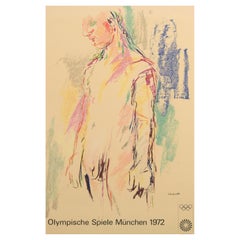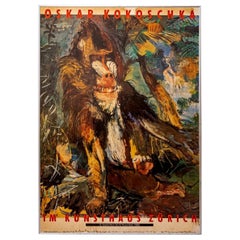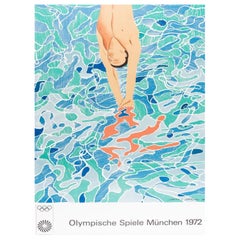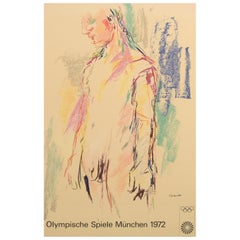Oskar Kokoschka
Austrian, 1880-1980
Oskar Kokoschka (1 March 1886 – 22 February 1980) was an Austrian artist, poet and playwright best known for his intense expressionistic portraits and landscapes. He was second child to Gustav Josef Kokoschka, a Czech goldsmith, and Maria Romana Kokoschka (née Loidl). His older brother died in infancy in 1887; he had a sister, Berta (born in 1889) and a brother, Bohuslav (born in 1892). Oskar had a strong belief in omens, spurred by a story of a fire breaking out in Pöchlarn shortly after his mother gave birth to him. Kokoschka’s life was not easy mainly due to a lack of financial help from his father. They constantly moved into smaller flats, farther and farther from the thriving center of the town. Concluding that his father was inadequate, Kokoschka drew closer to his mother.
Among Kokoschka’s early works were gesture drawings of children, which portrayed them as awkward and corpse-like. Kokoschka had no formal training in painting and so approached the medium without regard to the “traditional” or “correct” way to paint. The teachers at Kunstgewerbeschule helped Kokoschka gain opportunities through the Wiener Werkstätte or Viennese Workshops. Kokoschka’s first commissions were postcards and drawings for children. Kokoschka said that it gave him “the basis of [his] artistic training”.[1] His early career was marked by portraits of Viennese celebrities, painted in a nervously animated style.
He volunteered for service as a cavalryman in the Austrian army in World War I, and in 1915 was seriously wounded. At the hospital, the doctors decided that he was mentally unstable. Nevertheless, he continued to develop his career as an artist, traveling across Europe and painting the landscape.(Biography provided by Marlborough New York)
2
to
2
2
2
2
1
2
1
1
2
2
1
1
34
5,356
4,003
2,458
2,234
Creator: Oskar Kokoschka
1972 Olympic Poster by Oskar Kokoschka
By Oskar Kokoschka
Located in London, GB
This original vintage poster by Oskar Kokoschka is from the 1972 Olympic Games held in Munich, Germany. Posters were important for the marketing of this event, the XX Olympiad, which...
Category
1970s German Modern Vintage Oskar Kokoschka
Materials
Paper
Affiche Polychrome - Oscar Kokoschka - Exposition Au Kunsthaus - Circa 1986
By Oskar Kokoschka
Located in CRÉTEIL, FR
Large polychrome poster for the Oskar Kokoschka exhibition at the Kunsthaus Zürich from 5 September to 9 November 1986.
Very fine colour print pasted on panel.
Period : XXth centu...
Category
20th Century Austrian Other Oskar Kokoschka
Materials
Paper
Related Items
1972 Munich Olympic Games - David Hockney Original Vintage Poster
By David Hockney
Located in Winchester, GB
Celebrated British artist David Hockney was one of 29 artists commissioned to produce posters for the 1972 Munich Olympic Games. In the run-up to ...
Category
1970s German Vintage Oskar Kokoschka
Materials
Paper
Free Shipping
H 41.5 in W 27.6 in D 0.1 in
Midcentury "Exposition Vallauris" Poster by Pablo Picasso
By Pablo Picasso
Located in San Diego, CA
Highly collectible midcentury "Exposition Vallauris" poster by Pablo Picasso, circa 1950s. The piece is from the French Posters collection an...
Category
20th Century French Mid-Century Modern Oskar Kokoschka
Materials
Paper
Paris 1937 -- Exposition Internationale
By Eugene Beaudoin and Marcel Lods
Located in London, GB
Original French poster for the Exposition International in Paris, 1937.
This award-winning Art Deco design was created by Eugene Beaudoin (1898-1983) and Marcel Lods...
Category
1930s French Art Deco Vintage Oskar Kokoschka
Original 1992 Barcelona Olympic Poster Designed by Jean-Michel Folon
By Jean-Michel Folon
Located in London, GB
Jean-Michel Folon (1 March 1934 – 20 October 2005) was a Belgian artist, illustrator, painter, and sculptor
The first exhibition of his watercolors was in New York in 1969 in the Lefebre Gallery. One year later he exhibited in Tokyo and in the Il Milione gallery in Milan. He also participated in the XXVth Venice Biennale. In 1973 he joined the selection of Belgian artists in the XXVth São Paulo Biennale, where he was granted the Grand Prize in Painting. Over the years his work concentrated on different techniques, including watercolor, etching, silkscreen, illustrations, mosaics, and stained glass, which showed the diversity of his art. His work Ein Baum stirbt - Un albero muore, 1974, is by Museo Cantonale d’Arte [de] of Lugano. He also designed numerous posters, often for humanitarian causes. Around 1988 he created his first sculptures made out of wood. He then moved on to creating sculptures in clay, plaster, bronze and marble, while continuing to paint.
Several museums dedicated exhibitions to him, among them the Musée des Arts Décoratifs in Paris in 1971, the Museum Boijmans Van Beuningen in Rotterdam in 1976, the Institute of Contemporary Arts in London in 1977, the Musée Picasso in Antibes...
Category
1990s Belgian Modern Oskar Kokoschka
Materials
Paper
Pierre Soulages Original 1972 München Olympic Poster
By Pierre Soulages
Located in Weesp, NL
Immerse yourself in the spirit of sport and art with the iconic 1972 München Olympic Poster created by the celebrated artist Pierre Soulages. This poster not only commemorates the hi...
Category
1970s French Mid-Century Modern Vintage Oskar Kokoschka
Materials
Paper
1972 Munich Olympic Games - Valerio Adami Original Vintage Poster
By Valerio Adami
Located in Winchester, GB
Italian painter Valerio Adami was one of 29 artists commissioned to produce posters for the 1972 Munich Olympic Games. In the run-up to the 1972 Games, the Organising Committee decid...
Category
1970s Vintage Oskar Kokoschka
Materials
Paper
Friedensreich Hundertwasser, Olympic Munich Games 1972, Original Poster
By Hundertwasser
Located in Praha, CZ
- rare
- marked
- original
- can be framed and glazed.
Category
1970s German Mid-Century Modern Vintage Oskar Kokoschka
Materials
Paper
H 40.16 in W 25.2 in D 0.4 in
Razzia, Original Vintage Poster, 1986
By Razzia (Gérard Courbouleix–Dénériaz)
Located in SAINT-OUEN-SUR-SEINE, FR
Original and hand signed original poster dating from 1986 by Razzia (Gerard Courbouleix Deneriaz; b.1950).
This is a hand signed open edition poster and not a reproduction.
This po...
Category
20th Century French Modern Oskar Kokoschka
Materials
Paper
Original Barcelona 1992 Olympic Poster by Antonio Saura for the XXV Olympiad
By Antonio Saura
Located in London, GB
He began painting and writing in 1947 in Madrid while suffering from tuberculosis, having already been confined to his bed for five years. In his beginnings he created numerous drawings and paintings with a dreamlike surrealist character that most often represented imaginary landscapes, employing a flat smooth treatment that offers a rich palette of colors. He claimed Hans Arp and Yves Tanguy as his artistic influences.
He stayed in Paris in 1952 and in 1954–1955 during which he met Benjamin Péret and associated with the Surrealists, although he soon parted with the group, joining instead the company of his friend the painter Simon Hantaï. Using the technique of scraping, he adopted a gestural style and created an abstract type of painting, still very colorful with an organic, aleatory design.
The first appearances in his work of forms that will soon become archetypes of the female body or the human figure occur in the mid-1950s. Starting in 1956 Saura tackled the register of what will prove to be his greatest works: women, nudes, self-portraits, shrouds and crucifixions, which he painted on both canvas and paper. In 1957 in Madrid he founded the El Paso Group and served as its director until it broke up in 1960. During this period Saura met Michel Tapié.
During the 1950s he had his first solo exhibition at the Rodolphe Stadler Gallery in Paris, where he regularly exhibited throughout his life. Stadler introduced him to Otto van de Loo in Munich and Pierre Matisse in New York City, both of whom exhibited his work and represented him, and eventually his paintings were collected by major museums.
Limiting his palette to blacks, grays and browns, Saura asserted a personal style that was independent of the movements and trends of his generation. His work followed in the tradition of Velasquez and Goya. Starting in 1959 he began creating a prolific body of works in print, illustrating numerous books including Cervantes's Don Quijote, Orwell's Nineteen Eighty-Four, Nöstlinger's adaptation of Pinocchio, Kafka’s Tagebücher, Quevedo’s Three Visions, and many others.
In 1960 Saura began creating sculptures made of welded metal elements which represented the human figure, characters and crucifixions. In 1967 he settled permanently in Paris, and joined the opposition to Francoist Spain. In France he participated in numerous debates and controversies in the fields of politics, aesthetics and artistic creation. He also broadened his thematic and pictorial register. Along with his Femmefauteuil (literally "Womanarmchair"), he also worked on the series "Imaginary Portraits",and Goya’s Dog...
Category
1990s Spanish Modern Oskar Kokoschka
Materials
Paper
H 0.04 in W 27.56 in D 19.69 in
Original Poster Munich Olympic Games 1972 by Paul Wunderlich
By Paul Wunderlich
Located in Praha, CZ
- Original.
- Can be framed and glazed.
Category
1970s German Mid-Century Modern Vintage Oskar Kokoschka
Materials
Paper
Original Barcelona 1992 Olympic Poster by Josep Guinovart for the XXV Olympiad
By Josep Guinovart
Located in London, GB
Josep Guinovart (20 March 1927 in Barcelona – 12 December 2007 in Barcelona) was a Catalan painter most famous for his informalist or abstract expressi...
Category
1990s Spanish Modern Oskar Kokoschka
Materials
Paper
H 0.04 in W 27.56 in D 19.69 in
Original Barcelona Olympic Poster by Antoni Clavé for the XXV Olympiad
Located in London, GB
Antoni Clavé (5 April 1913 – 1 September 2005) was a Catalan master painter, printmaker, sculptor, stage designer and costume designer. He was nominated for two Academy Awards (Best Art Direction and Best Costume Design) for his work on the 1952 film Hans Christian Andersen.
Clavé was one of Spain's best known and most celebrated artists. His work evolved from a baroque, ornamental style to a pure, minimal aesthetic. In his later years, his work is completely abstract, employing expressive lines and exploring the boundaries of collage, objet trove, shading, texture and color. He was trained at the School of Fine Arts, Barcelona, where he was taught by Angel Ferrant and Felix Mestres. With his works being influenced by artists such as Bonnard, Vuillard and Roualt. He is best known for his lyrical abstractions, works which combine paint with collage.
Clavé fought in the Republican Army in the Spanish Civil War, and served as draughtsman for the Republican government. He arrived in France as a refugee in 1939 and went straight to Paris to work as an illustrator. His first one-man exhibition was held at the Au sans Pareil bookshop, 37 Avenue Kleber in Paris in 1940, where Max Ernst and other leading figures from the Dada movement had their first exhibitions in the 1920s. In 1944 Clavé met Picasso and began making figure compositions that were deeply influenced by Picasso's work, featuring kings, harlequins, children, and still lives.
His theatrical designs have appeared on stages in New York, Munich, London and Paris, as well as in the 1952 film Hans Christian Andersen. His works include sets for opera, theatre, and ballet, most notably for Roland Petit's ballet company, Les Ballets des Champs Elysees (1945-1951) including Los Caprichos (1946) Carmen (1949) and a comic ballet choreographed by Roland Petit called Deuil en 24 Heures.In 1951 he designed La maison de Bernarda Alba (The House of Bernarda Alba) for director Marcel Achard at the Theatre de l'Oeuvre in Paris, and in 1962, a production of The Marriage of Figaro for Maurice Sarrazin at Théatre de la cour de l'Archeveché in Aix-en-Provence.
In 1957 Clavé began to design carpets and from 1960 he began to work on sculptural bas reliefs...
Category
1990s Spanish Modern Oskar Kokoschka
Materials
Paper
H 0.04 in W 27.56 in D 19.69 in
Previously Available Items
1972 Olympic Poster by Oskar Kokoschka
By Oskar Kokoschka
Located in London, GB
This original vintage poster by Oskar Kokoschka is from the 1972 Olympic Games held in Munich, Germany. Posters were important for the marketing of this event, the XX Olympiad, which...
Category
1970s German Modern Vintage Oskar Kokoschka
Materials
Paper
Oskar Kokoschka Climbing Horse
By Oskar Kokoschka
Located in Vienna, AT
Oskar Kokoschka. Climbing horse. Lithograph, test print with dedication. List of works Wingler / Welz 220.
Description:
Oskar Kokoschka (01.03.886 Pöchlarn - 22.02.1980 Montreux); ...
Category
1960s Austrian Vintage Oskar Kokoschka
Oskar Kokoschka furniture for sale on 1stDibs.
Oskar Kokoschka furniture are available for sale on 1stDibs. These distinctive items are frequently made of paper and are designed with extraordinary care. Many of the original furniture by Oskar Kokoschka were created in the modern style in europe during the 20th century. If you’re looking for additional options, many customers also consider furniture by Ernst Fuchs, and Paul Wunderlich. Prices for Oskar Kokoschka furniture can differ depending upon size, time period and other attributes — on 1stDibs, these items begin at $907 and can go as high as $924, while a piece like these, on average, fetch $916.
Creators Similar to Oskar Kokoschka
Questions About Oskar Kokoschka
- 1stDibs ExpertMarch 22, 2022In his portraits, Oskar Kokoschka was trying to capture the inner psyche of his subjects. As an Expressionist artist, he believed this to be far more important than accurately recording their physical characteristics. On 1stDibs, find a variety of Oskar Kokoschka art.





